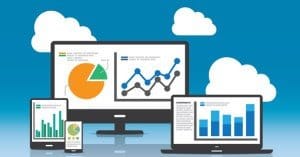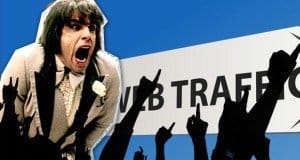Is There a Correlation Between Traffic and Rankings?

At first glance, the question in the headline seems simple, as a yes or a no. Is there a correlation between traffic and rank? Does more traffic mean a higher rank? Or does traffic have nothing to do with rank? Unfortunately, a simple yes or no answer wouldn’t mean anything here.
Correlation vs. Causation
The first issue to address with the question is the wording. See, correlation simply means similar trends in two measurements. For example, there is a strong correlation between the divorce rate in Maine and the per capita consumption of margarine in the United States. The correlation between the two, however, is meaningless; people don’t decide they want divorces because too much margarine was eaten somewhere in the country.
On the other hand, you have causation. There is a strong causation between the number of people seeing a movie and the amount of butter consumed in that movie theater. More movie-goers means more popcorn sold, which means more butter consumed. One causes the other.
So, if you have traffic on the rise, and your search ranking is rising, you would have a correlation between traffic and ranking, but that correlation is meaningless. What you really want to know is if there is a causation between the two; does having more traffic cause higher rankings?
For a quick summary:
- Is there a correlation between traffic and rank? Yes.
- Does more traffic cause higher ranking? Not necessarily.
- Does a higher ranking cause more traffic? More likely.
More Traffic, Higher Rank
In some ways, having higher traffic numbers is going to result in a higher ranking. This is because, as you build more dedicated readers, you also build some of the metrics that are used to calculate ranking. Some of these factors include:
- Organic clicks. More traffic means more people clicking on your links in the search results, which can reinforce a ranking and boost it.
- Direct traffic through Chrome. A high number of repeat users using Google’s browser is a quality signal, and higher quality sites have higher rankings.
- Comment frequency. Pages with more traffic tend to have more comments, and pages with more comments are generally higher quality, thus earning higher rankings. This assumes that the comments are not spam, of course.
- Time spent on site. The longer users linger on your site after clicking through a Google search link, the higher Google assumes the quality of the pages is. Again, higher quality means a higher ranking.
Better Traffic, Higher Rank
Consider this thought experiment. You have two identical sites. These identical sites have identical content throughout, identical backlink profiles, identical advertising and identical URLs. One site pays for a million visitors, while the other site relies on entirely organic traffic. The site paying for traffic will have a much higher number of hits, but the percentage of satisfied users is much lower.
In this instance, the site with higher quality traffic is going to rank higher than the site with low quality bot or clickfarm traffic. To put it another way, a site with 100 users, all of whom comment, share the link on Google+ and write about the page on their blog is going to do better than a site with 10,000 users, all of whom bounce after less than ten seconds spent on site.
More Pages or More Quality
Here’s another scenario to consider. Which site will do better; the one with 100 valuable pages, or the one with 10,000 low-quality pages?
In the past, the site with more content was almost always going to come out on top. The sheer number of pages was a shotgun approach to ranking. More pages meant more opportunities for other sites to link in without stacking all the links on one page.
As of Google Panda, however, that’s simply no longer the case. Panda makes Google care much more about quality, more than ever before. It also gives Google a whole host of factors to consider and measure that quality and relevancy for a query. Now, a site with only a hundred high quality pages can very easily outrank a page with thousands of low quality skimmed content. In fact, the low quality site very likely will fall victim to a penalty.
This is true even of sites of middling quality. Add in a little SEO emphasis, such as a focus on local keywords, and a small site can out-rank a large site in particular circumstances. It’s how a small soft-drink company could out-rank Coca-Cola for certain queries, for example.
Engagement as a Game of Numbers
All of this considers users to be one-trick ponies, with their page load, hit, view – whatever you want to call it – as their only valuable interaction with a page. This is far from true, of course. Users can do a number of things that are valuable to a page and boost search ranking. For example:
- Commenting on the blog post.
- Sharing the post to their friends manually.
- Sharing the post via any of the numerous social networks.
- Linking to the post on their blog.
However, engagement is something of a game of numbers. Typically, only a small percentage of your viewers are going to perform an engagement action. As the value of the engagement increases, the number of people willing to do it decreases.
One way to increase your engagement in absolute numbers is to likewise increase your traffic in absolute numbers. This assumes that you maintain the same engagement percentage, which means that you have to maintain the quality of your traffic. Buying low quality traffic isn’t going to help, because your engagement percentage drops. On the other hand, boosting your engagement within your current audience help, but doesn’t necessarily help as much as boosting the absolute numbers themselves.
In this way, a higher traffic number can be purely beneficial; more readers means more people performing engagement actions, which increase your search ranking.
More Traffic Brings More Ranking Factors
Way at the beginning, the most likely scenario was the one that reverses the causation. Higher traffic can help cause higher rankings, but it’s far more likely that higher rankings cause higher traffic.
The reason for this is simple; people trust Google. People trust Google to put the best results on top. Therefore, if a page is on the top of the search rankings, it’s most likely going to be the best results for that query. Users click it and, only if they’re dissatisfied, click back and try another link. Google strives for the top result to be the most relevant page available, to support this assumption.
What you end up with is a feedback loop of sorts. Having a higher rank helps bring in more traffic. Having more traffic helps increase various ranking factors, helping to boost your ranking versus your competition. Better ranking factors, trust and quality all help push your ranking higher, which brings in more traffic.
 ContentPowered.com
ContentPowered.com






